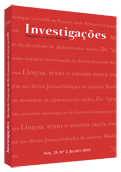Processo de Desenvolvimento Sintático: investigação do desenvolvimento das habilidades metalinguísticas do sujeito PA
Abstract
No presente artigo discutem-se algumas características do desenvolvimento sintático em crianças em processo de aquisição da linguagem. O principal objetivo é verificar como esse processo se desenvolve, uma vez que a maioria das pessoas comuns dificilmente se pergunta como uma criança aprende a falar: o que provoca surpresa e estranhamento é o fato de a criança não falar. Mas aquilo que é algo tão natural e esperado – o falar – está envolvido e imbricado em um profundo processo sociocultural e de amadurecimento biopsíquico do sujeito.References
CORREA, Letícia M. S. 2009. Aquisição Da Linguagem: Uma Retrospectiva Dos Últimos Trinta Anos. Disponível em: http://www.scielo.br/pdf/delta/v15nspe/4022.pdf. Acesso em 27 nov.
COSTA, J.; SANTOS, A.L. 2001. A falar como os bebés. O desenvolvimento linguístico das crianças. Lisboa: Caminho.
FINGER, I.; QUADROS, R. M. de (Orgs.). 2008. Teorias de Aquisição da Linguagem. Florianópolis: Editora da UFSC.
FROMKIN, V.; RODMAN, R. 1993. “Da Boca dos Bebés: Aquisição da Língua pela Criança”. In: Introdução à Linguagem. São Paulo: Editora Coimbra Almedina, p.351-373.
LÓPEZ GARCÍA, A. 1988. Psicolinguística. Madrid: Editorial Sintesis.
LURIA, A. R. 1984. Conciencia y lenguaje. Tradução para o castelhano de Marta Shuare. Madrid: Visor Libros. 2 ed.
MACHADO, J. B. 1994. O desenvolvimento da sintaxe nas crianças. Disponível em: http://alfarrabio.di.uminho.pt/vercial/letras/ensaio33.htm. Acesso em: 23 mar de 2009.
MIOTO, C.; SILVA, M. C. F.; LOPES, R. E. V. 2004. Novo Manual de Sintaxe. Florianópolis: Editora Insular.
SCLIAR-CABRAL, L. 1977. A Explanação Linguística em Gramáticas Emergentes. Tese de Doutorado, São Paulo: USP.
Downloads
Published
How to Cite
Issue
Section
License
Copyright (c) 2010 Lidiomar José Mascarello

This work is licensed under a Creative Commons Attribution 4.0 International License.
Authors who publish with Revista Investigações agree to the following terms:
Authors retain copyright and grant the journal right of first publication with the work simultaneously licensed under the Creative Commons Attribution 4.0 International (CC BY 4.0) license that allows others to share the work with an acknowledgement of the work's authorship and initial publication in this journal.
Authors are able to enter into separate, additional contractual arrangements for the non-exclusive distribution of the journal's published version of the work (e.g., post it to an institutional repository or publish it in a book), with an acknowledgement of its initial publication in this journal.
You are free to:
Share — copy and redistribute the material in any medium or format for any purpose, even commercially.
Adapt — remix, transform, and build upon the material for any purpose, even commercially.
The licensor cannot revoke these freedoms as long as you follow the license terms.
Under the following terms:
Attribution — You must give appropriate credit , provide a link to the license, and indicate if changes were made . You may do so in any reasonable manner, but not in any way that suggests the licensor endorses you or your use.
No additional restrictions — You may not apply legal terms or technological measures that legally restrict others from doing anything the license permits.

